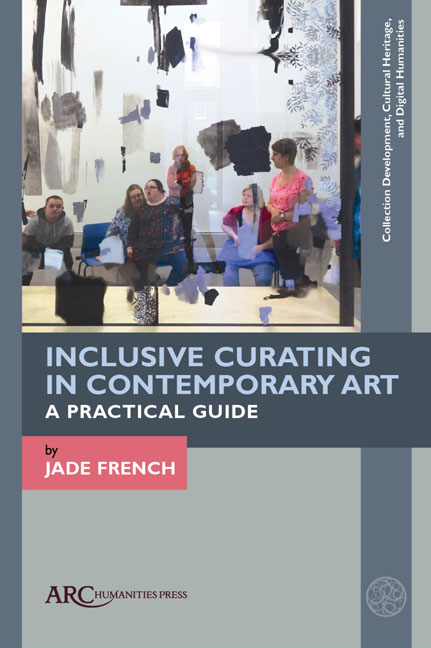Chapter 5 - Installation and Exhibition
Published online by Cambridge University Press: 20 November 2020
Summary
With artwork and interpretation plans nearing completion, the next step in the process sees inclusive curators now planning the exhibition installation and marketing, as well as organizing an exhibition opening. Though the installation is always the shortest part of creating an exhibition, it is also the most intense and time pressured, making it a nerve-wracking experience. Although the basis of every exhibition installation is similar, each has its own unique set of circumstances, depending on who you work with, and the objects being installed. This is what causes installations to be an unpredictable task, however tightly planned.
The term “installation” describes the process of constructing the exhibition into the gallery space. This includes painting walls or floors, fixing or placing the artwork and interpretation in the space, adjusting or adding lighting, and fitting any signage or wayfinding. As many museums tend to have dedicated technical staff who are trained for installing, inclusive curators instead take on an advisory role whereby they “assist in resolving any issues or questions that might develop,” “maintain quality control,” and generally oversee that the exhibition comes together in accordance with the plans. For exhibitions which feature more technically specific artwork, such as high-spec projections, sound or moving image, installations can also be a technical process that require a range of external contractors including electricians and structural engineers. Installations are always supported by visual plans, which enable curators to bring together these various elements of the exhibition with a range of stakeholders.
This final phase of inclusive curating makes visible the curator's role as a mediator. The inclusive curators now are required to move and communicate between much larger networks beyond the facilitator and artists, to include the museum's programming, front of house, marketing, press, and the technical installation teams, as well as those beyond the institution such as external press, contractors, and visitors. Equally, in the final stages of an exhibition the artwork becomes materially bound. The term “object-position,” borrowed from material studies, can be used to describe the relationship between the material object and human, social, and cultural practices and experiences. Artwork which may have been discussed in regard to ideas, concepts, plans, and workshops now becomes a tangible and material object.
- Type
- Chapter
- Information
- Inclusive Curating in Contemporary ArtA Practical Guide, pp. 97 - 112Publisher: Amsterdam University PressPrint publication year: 2020



